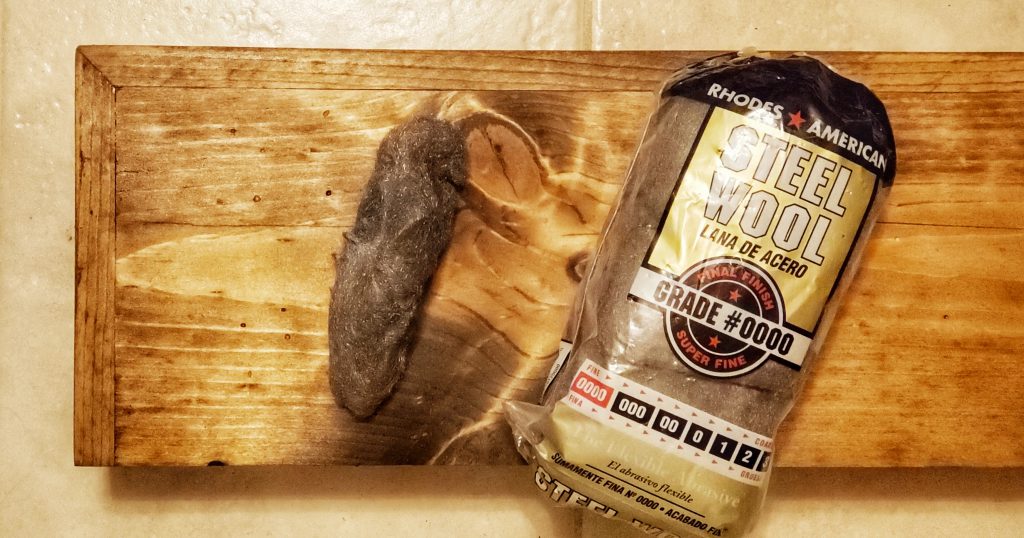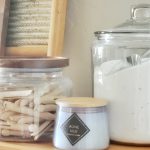
Most projects involve some sort of prep work having to deal with wood unless you are buying a ready cut design of wood from a place like Hobby Lobby.
However, since his hours and available times for projects are less than mine, and let’s face it; I’m not patient when it comes to getting projects done. I asked him to walk me through how to do some of these initial steps. I’m writing them down not only in the hopes that they might help you simplify your project process but so that I don’t forget with my mama brain and have a reference to refer back to 🙂
Where to start
You want to attempt to do a project, but don’t know quite where to start? Sand with what? What stain to use? How to finish a piece of wood? If so, this post is for you. Similar to you, I am capable of trying just about anything. But I knew absolutely NOTHING when it came to woodworking.
Along the way, I’ve picked my hubby’s brain since he is the woodworker out of the two of us. So I hope his tips and tricks help you to feel confident taking on your own!
This post contains affiliate links, which means I may earn a small commission if you purchase through them—at no extra cost to you. Your support means the world and helps keep this blog running. I only share products we actually use and love, and I’ve included them here for your convenience. Thank you for supporting our journey!
Supplies you’ll need:
- Sander (hubby’s favorite is an orbital sander)
- Sandpaper – 100 grit for rounding out the edges, 150 for smoothing & 220 grit for finish
- Steel wool 0000– for smoothing out after applying each polyurethane step
- Polyurethane– for sealing in the wood after staining
- Wood Stain – I used Minwax’s Dark Walnut. (If you want a little lighter color, try Special Walnut Stain
- Stain Pad – This is for applying the stain.
- Cloths– for wiping off excess stain
- Tack Cloths– for removing sanding dust as well as steel wool particles
- Painters Pyramid Stands
- Lumber – 2″ (actual 1.5″) X 8″ (actual 7.5″) X 10ft wood board (cut down to size)
Step 1 – Get your lumber

I still remember one of my best friends telling me Home Depot was her favorite store….
I didn’t get it at the time. Now, I 100% agree 🙂
Time to get your lumber! As you decide where to get it, keep in mind that the beauty in getting it from a hardware store, such as my favorite, Home Depot, is that they will cut it for you. FOR FREE 🙂
This is my favorite thing ever. I’m not the most patient person. As soon as we start a project, I’m already itching for it to be done. Like yesterday 🙂
Having them cut it for you in store means it will fit in your car easily and when you get home, you are ready to jump in and start making your shelves!
Prepare your shelves
Step 1 – Cut your wood

If you chose to have it cut when you bought it, you get to skip this step! Otherwise, time to get it cut to length. Personally, even though we have all the tools at home to cut it; I’m all about simplifying. So I would suggest taking advantage of the help and having the Home Depot make the two simple cuts for you.
Step 2 – Plane your wood (optional)

Shhhh! Don’t tell my hubby I used his tools on the garage floor! 😉
Do you have to do this step? Not necessarily. But if you have a planer, its worth the 10 extra minutes of work.
Why
What planing does is when you buy a long piece of wood, more often than not, the wood is a little warped. Sanding will remove the roughness a little, but not as much as planing. Planing will help make both sides flat and parallel to each other.
How
To plane the wood, place it in the feed, and adjust the height of the planer to be a tiny bit higher than that of the wood. Start with the crown side facing up (bottom side should be the cupped side since you want the side with two points of contact touching the feed base of the planer first). Pass the wood through on one side until it is flat.
Think of your wood as a letter “C” if it is cupped. Look at your board from the ends. When you make the letter “C” with your hands, the tips of your fingers are the points that you want touching the feed base. Hold up your board again, find the “C” and turn the board clockwise so the points are facing down
Once the first side is flat, flip the board and then turn the knob. This lowers the planer and you are ready to once again pass the wood through on both sides.
I did this about 4 times on each side of the shelf. But every piece of wood will be different. Use your best judgment and when you feel the shelf is flat enough to hold your items without them rocking, then you are good to go on to step 3 🙂
Step 3 – Sand

We were out of sanding disks for our orbital sander, and so I made do with this one 🙂
I am the first to admit, I am not the biggest fan of sanding…..in fact, I really really really dislike it 🙂 However, it is the most important step of most projects. Especially any project you want to last and will be applying stain to it.
Why
This part of the prep work smooths the surface of the wood. This will give you a uniform surface which will yield a better quality finish regardless of the finish you apply. Basically, this step will leave you with a professional looking finished product!
An orbital sander is your friend
This step can be done with a hand sander, but it will take forever. However, if you will be doing more than just a couple of home projects, I can’t recommend enough going with a power sander. It will pay for itself in all the time and frustration it will save you. This is similar to the one we have and it gets used all the time. The orbital sander is the favorite in our house for all our projects because it doesn’t leave sand or scratch marks in the wood as a result of repetitive sanding strokes.
Any time you sand wood, start with a lower grit paper ( 100 grit ). Work your way up to finer grit (ie. higher number). The low grit sandpaper removes any wood slivers and does the grunt of the work. Use a 100 grit to round out the edges of the shelves. Move to a 150 grit for sanding the faces and sides of the wood smooth. This is a good grit to transition between the shaping done with the 100 and the finishing with the 220.
If you were to skip straight to the 220 grit, you’d be wasting a lot of the 220 grit sandpaper to smooth it out instead of just finishing the surface. Lastly, use a 220, finer grit, for finishing the sanding. You will want to make sure to sand the rough ends of the wood as well!
Cleaning
After you are finished sanding, clean off all that sand dust WELL! You’ve taken all the time to get the wood prepared to stain. The last thing you want is particles of dust left that will create a bumpy finish as you apply the stain if it isn’t all removed. Take your time with this step.
Start by vacuuming off the bulk of the dust. I always use a shop vac for this. As tempting as it might be to grab your house vacuum, don’t. A shop vac is meant to vacuum up larger particles and pieces and is less likely to get clogged. The remaining dust will be a breeze to remove with these Tack C
Take extra time to make sure you do this part thouroughly. It will pay off in the end, promise 😉
Step 4 – Stain

Goof up on my part. I used a brush, which will work. But you are better off using a stain pad!
You’re almost done with the shelves!
Almost the final step is
For how to apply the stain, FOLLOW THE DIRECTIONS ON THE STAIN CAN! This will help you to achieve the best results as directions can vary.

Keep in mind, this step is messy! Grab some cardboard or a tarp to put under your shelves. Then elevate the wood off your surface with these awesome Painter’s Pyramid Stands.
They are great because they allow you to stain the entire piece of wood at once. This is quicker than waiting for one side to dry before staining the other.
Plus they are perfect to be be re-used time and time again for all your different projects.
Again, not a necessity, but the stain is messy. I always choose to use these gl
Applying the stain
The easiest way to apply stain and end up with professional results are these stain pads. They are easy to use, and unlike brushes they won’t leave brush marks. Well crap….because guess what I used? A paint brush.
I guess this is one more lesson on why I should not be so stubborn and ask hubby for help sometimes. I thought the brush was fine and was all proud of myself for doing this project alone while he was at work. Apparently with stain, you have to be very careful to apply in the direction of the grain (lines) of the wood. By using a brush, you are more likely to end up with brush marks. I just learned this as I was having him double check my post directions, since he is the builder in our house. Oops.
So, learn from my mistake 🙂 Go with these pads!
Keep in mind, that most stains need to be wiped off before they dry. The longer you leave the stain, the darker the finish will be. I set a timer for 5 minutes before wiping, and for me, they turned out a little too dark. Next time, I will do 2-3 minutes and then wipe! You can always do a little longer on the second coat if it isn’t dark enough for you!
For wiping off the stain, grab a package of clean rags like these. These will be easiest to use because they won’t tear as you wipe off the excess stain that hasn’t absorbed into the wood.
Applying the Polyurethane

These are the final steps before your wood is prepped, finished and ready for whatever project you had in mind for it!
1 / Dry Time. After the allotted dry time has passed in reference to the directions on the can of your stain, you are ready to add the polyurethane.
2 / Add the polyurethane coat. This is a protective coat that hardens and creates a hard shell on the surface. This is important because it protects the surface from normal wear. Some even have UV resistance which prevents color
3 / Use steel wool. After you have again followed the dry time stated on the can, you are ready for using this steel wool 0000.
Steel wool is similar to fine sandpaper. The benefit is that it smooths out the layer of poly and creates a smoother sub-straight for any subsequent applications. This does not need to be done roughly. Instead, pretend as if you are simply wiping the surface of the wood. Think light. You don’t
Some people choose to instead use a hand sander for this step; you can. However, I have found (through my handy hubby teaching me:) that when you use the steel
If you do choose to sand, here are the comparisons between steel wool and sandpaper.
00 – 180 grit sandpaper
000=280 grit sandpaper
0000=400 grit sandpaper
4 / Use a damp cloth or Tack Cloth. To remove the steel wool particles, use one of these two options, a damp cloth or my favorite, a Tack Cloth to clean the board so you are ready for the next poly step.
5 / Repeat (steps 2 & 3) x 3. After you have cleaned the board well, time to repeat steps 2 and 3 two to three more times; making sure to allow ample drying time in between.
There you go! Your board is ready for whatever project you are working on!
Hope this helped!
Happy “projecting”
XO,
Morgan




Comments are closed.